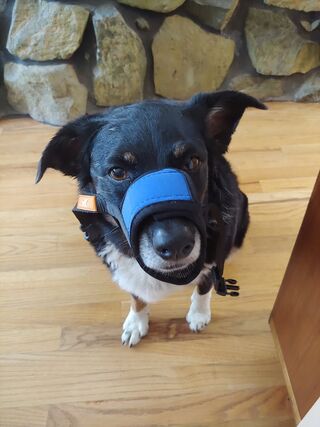Fear
Why Muzzle Training Your Dog Is A Good Idea
Comfortably wearing a muzzle is a useful skill for all companion dogs.
Posted July 17, 2020

If you perform an internet search for images of “dog muzzle,” you’ll likely pull up a collection of photos showing large, powerful dogs snarling behind a Hannibal Lecter-style face cage, providing confirmation for one of the most persistent stereotypes related to companion dogs: Muzzles are for vicious dogs who are a serious bite risk. This could not be farther from the truth. The fact is, being able to comfortably wear a muzzle without feeling fear is a skill that should be in every companion dog’s toolbox.
A new attitude toward muzzles has emerged over the past few years, a confluence of the fear-free movement and positive, reward-based training philosophy. The association of muzzles with gentle, fear-free dog care and training may seem counterintuitive. Muzzles used to be associated with the authoritarian treatment of dogs and the deliberate training of dogs to be ferocious. Now, muzzles are increasingly recognized as a component of responsible and responsive care. I am advocating for muzzle-training not as a dog trainer or veterinarian, but as an ethicist and someone who cares about dogs and their people. To be clear, I am not advocating for muzzles themselves, but for muzzle-training.
Why is muzzle-wearing a useful skill for dogs to have? Here are the five top reasons:
Top Five Reasons to Muzzle-Train
1. To reduce stress at the veterinarian’s office
Unless you have the most chilled-out dog in the world, there will come a time when a veterinarian needs to perform some examination or procedure that your dog would prefer not to experience. Most veterinary offices will place a muzzle on a dog in these circumstances, to prevent the dog from biting staff. If a dog is not accustomed to wearing a muzzle, he or she will likely find it extremely stressful. This is something we can control: If a dog is comfortable in a muzzle and is used to having a muzzle placed on his face, one potential stressor has been alleviated.
2. To keep a reactive, fearful, or nervous dog safe and to protect people and other animals
Being comfortable in a muzzle may mean that a dog who is dog-reactive or people-reactive can have more freedom to be outside on trails or in off-leash areas.
3. To send a message to other dog owners that a dog does not like to be approached
Some dogs need space and do not like to be approached by other dogs or by people. Having a muzzle on a dog sends a signal that a dog would prefer to be left alone.
4. To facilitate emergency care
I have long been aware that wearing a muzzle is a good skill for a dog to have in her toolbox, but I just hadn’t gotten around to buying a muzzle and training my dog Bella to be comfortable having it on. The need arose during a camping trip in the Colorado high desert. Bella stepped on a cactus and had a million tiny barbs in her right front paw. Bella was scared and in pain and would not let us touch her foot.
We were woefully unprepared for this situation. We had to fashion a muzzle out of a leash and physically restrain Bella while slipping it around her nose. She struggled, and we struggled, and everyone was stressed out. Cactus removal was successful but under less than ideal circumstances. After this mishap, and after kicking myself for not being more proactive, I added a soft muzzle to the dog first aid kit that I carry in my car and on hiking excursions and began a muzzle-training progression with Bella. Having a muzzle in emergency situations where a dog has been injured can speed up response time and keep everyone safe.
5. To protect a dog who likes to eat random inedible stuff
Some dogs will ingest socks, underwear, plastic dinosaurs, squeakers from inside toys, aluminum foil—you name it, a dog has probably tried to eat it. And not infrequently, surgical intervention is the outcome. If you have a dog who is inclined to eat bad stuff, a muzzle can keep them safe if they need to be left unsupervised.
Take Time to Train Properly
Because muzzle-wearing is not natural to dogs and can be extremely scary and anxiety-provoking, it takes time and effort on the part of dog caregivers to teach a dog to wear a muzzle comfortably. Training involves a slow, gradual process of habituation to create positive associations with the muzzle. It can take several months and many, many bags of treats and lots of praise and patience (and the occasional "refresher course").
Obviously, it is ideal to start training during puppy-hood, but adult dogs can be successfully muzzle-trained, too (with "success" meaning that a dog feels no fear or discomfort having a muzzle placed over their nose, strapped behind their ears, and left on for a period of time).
It is important to get a muzzle that fits properly and is comfortable. A dog should be able to breathe freely, drink water, and pant.
References
Lots of good muzzle-training resources are available online. The Muzzle Up! Project is a good place to start. See also this article on muzzle training on the Pet Professional Guild website. The Muzzle Up! Project offers some tips on picking out the right muzzle, and Pet Expertise has a nice comparison chart.


